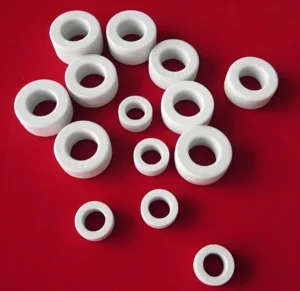
Understanding Nanocrystalline Core
Definition and Properties of Nanocrystalline Cores
Nanocrystalline core is magnetic core made from nanocrystalline materials, which is characterized by their extremely small grain sizes, typically in the range of 10 to 100 nanometers. These materials exhibit superior magnetic properties compared to traditional core materials. Key properties of nanocrystalline cores include:
- High Permeability: Nanocrystalline cores have exceptionally high magnetic permeability, allowing them to achieve higher inductance and more efficient magnetic flux handling.
- Low Core Loss: These cores exhibit significantly lower core losses, including hysteresis and eddy current losses, which translates to higher efficiency in electrical applications.
- High Saturation Flux Density: Nanocrystalline materials can withstand higher magnetic flux densities without saturating, making them suitable for high-power applications.
- Thermal Stability: They maintain their magnetic properties over a wide range of temperatures, ensuring reliable performance in various environmental conditions.
Comparison with Traditional Core Materials
When compared to traditional core materials such as silicon steel and amorphous steel, nanocrystalline cores offer several advantages:
- Silicon Steel: Silicon steel, commonly used in transformers and motors, has lower permeability and higher core losses compared to nanocrystalline cores. While it is cost-effective and widely available, silicon steel is less efficient, particularly at high frequencies.
- Amorphous Steel: Amorphous steel, known for its low core loss and decent permeability, is a step up from silicon steel. However, nanocrystalline cores outperform amorphous steel in terms of permeability and core loss, especially at frequencies above 10 kHz.
Benefits of Nanocrystalline Cores in Transformers
Enhanced Efficiency
Nanocrystalline cores significantly enhance transformer efficiency. They possess superior magnetic properties that result in much lower core losses compared to traditional materials like silicon steel and amorphous steel. The reduction in core losses, primarily due to lower hysteresis and eddy current losses, leads to improved magnetic permeability and higher inductance. Consequently, transformers with nanocrystalline cores can handle magnetic flux more efficiently, boosting overall performance.
Reduced Energy Losses
Nanocrystalline cores excel in reducing energy losses in transformers. They exhibit decreased hysteresis losses, which occur due to the lag between magnetization changes and the external magnetic field. Additionally, their smaller grain size minimizes eddy current losses, making them highly effective at high frequencies. This reduction in both hysteresis and eddy current losses ensures that transformers operate with higher efficiency and better performance, especially in high-frequency applications.
Compact and Lightweight Design
The use of nanocrystalline cores enables a more compact and lightweight transformer design. Their higher power density allows transformers to deliver the same or greater power output with a smaller core size. This reduction in size and weight is particularly beneficial in applications where space and weight constraints are critical, such as in portable devices and aerospace technology. A smaller transformer footprint without compromising performance translates to more efficient use of materials and space.
Improved Thermal Performance
Transformers with nanocrystalline cores benefit from improved thermal performance. These cores exhibit superior heat dissipation, maintaining optimal operating temperatures and preventing overheating. Enhanced thermal stability ensures efficient operation over a wide temperature range, reducing performance degradation. Improved thermal management extends transformer lifespan and minimizes the need for additional cooling systems, further enhancing efficiency.